A bunion can have many causes. It is important to recognize these symptoms in time. In the early stages, bunion / hallux valgus can be treated well with bunion correctors, exercises, physiotherapy, bandages, tapes or massages. In the late stage, it often helps to conduct buniom surgery. In this Bunion guide, we explain which bunion symptoms indicate hallux valgus and which exercises are able to obtain relief. However, it is always important to have your symptoms clarified and treated by a specialist (orthopaedist & trauma surgeon).
Reading time: 6 min
Author of the article: Dr. Klaus Pastl
Foot surgeon and hallux valgus specialist in Linz
The author is a renowned specialist in Austria for foot surgery and hallux valgus operations.
Updated 05.01.2023
Table of Contents
What is a bunion & how does it look like?
“Classic signs of an incipient bunion are a pain when wearing and walking with tight shoes. A bunion can be recognized by the fact that the big toe deviates from the center of the body (medial). The skin is often thickened and reddened at this point. This pressure point on the big toe can cause severe pain. In the early stages, bunion correctors, gymnastics, physiotherapy or bandages often help. In the advanced stages, bunion surgery is often the only option. ” Surgery has a high success rate,” says Dr Klaus Pastl, a bunion specialist from Linz.
Why did I get a bunion / Hallux Valgus?
“A bunion can be caused by wearing the wrong shoes. However, the cause is often also due to weak connective tissue or an acquired or congenital splayfoot. If you experience these bunion symptoms, you should talk to an orthopaedist or physiotherapist about a personal therapy. He or she will teach you exercises to strengthen the connective tissue or help you to avoid surgery by using special insoles. If your hallux valgus has to be operated on with a special surgical method, the use of natural implants like screws made of human bone, such as the Shark Screw®, is recommended to treat your painful forefoot. This treatment allows for natural healing,” says Dr. Klaus Pastl.
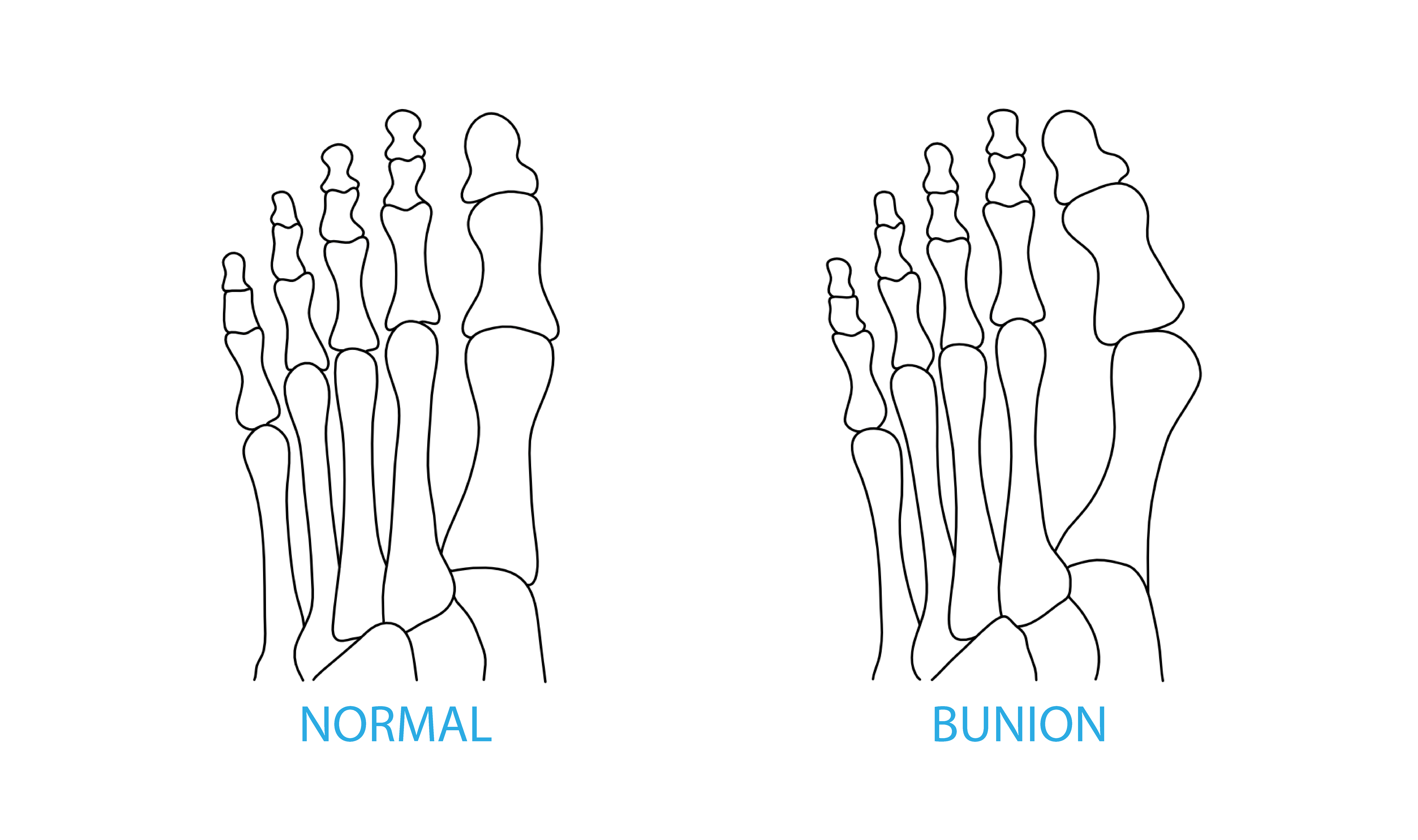
What does a bunion look like (Hallux valgus)?
Illustration of a classic Hallux valgus deformity. The drifting of the metatarsal head causes pain when walking. Bunion surgery often helps if patients are suffering.
Hallux valgus (Bunion) and hallux rigidus what is the difference?
Hallux valgus and hallux rigidus are both diseases that affect the metatarsophalangeal joint of the big toe. Although they are 2 different clinical pictures, it can happen that mixed forms of both diseases occur. Hallux valgus and hallux rigidus differ in the following characteristics:
Hallux valgus
Hallux valgus is an often painful deformity of the metatarsophalangeal joint of the big toe.
Hallux valgus -> Hallux = toe, valgus = crooked, bent
Hallux rigidus
Hallux rigidus is a stiff, rigid joint wear in the metatarsophalangeal joint of the big toe. The joint is difficult to move and painful.
Hallux rigidus -> Hallux = toe, rigidus = stiff, immobile, heavy
Bunion treatment
Women who like to wear shoes with high heels or people who are genetically predisposed to a bunion, simple exercises in everyday life help to prevent a bunion or to stop a beginning bunion. A simple bunion exercise: for prophylaxis and prevention, brush your teeth while standing on one leg, one minute on the right and one minute on the left. Is this too easy for you? While doing this, close your eyes and make figure-eight movements with your foot in the air. Through this bunion exercise, you will strengthen your arch.
Tip:
Physiotherapists can help you quickly and easily with a personal prevention programme.
Treatment options with or without surgery (OP)
“The first goal of bunion treatment is to reduce the patient’s pain as quickly as possible and to correct the deformity as best as possible. In addition, one wants to restore the functionality of the joint as much as possible. Like many diseases, bunion / hallux valgus can be divided into different degrees of severity. The patient’s therapy depends on this degree of severity. In addition to these therapies, there are also some approaches to a natural cure for hallux valgus. I like to divide my patients into three stages,” says Dr Klaus Pastl.
Schweregrad | Hallux valgus Winkel (IM) | Symptome | Behandlung |
| | Intermetatarsalwinkel (IM) unter 15° | gelegentliche Schmerzen im Alltag, Rötungen und verdickte Haut möglich | Physiotherapie, Fußgymnastik, Operation nach Austin, Schienen, Einlagen |
|| | Intermetatarsalwinkel (IM) zwischen 15° und 20° | häufige Schmerzen im Alltag, Rötungen, Druckstellen am Ballen, Schmerzen beim Tragen von Schuhen | Optimiertes Schuhwerk, Operation nach Scarf, Fußgymnastik |
||| | Intermetatarsalwinkel (IM) über 20° | Schmerzen auch im Ruhezustand, sowie beim Gehen und Laufen | Operation nach Scarf oder Lapidus-Arthrodese, Fußgymnsatik |
The treatment and possible exercises depend on the severity of the bunion. Surgical methods such as scarf osteotomy, Austin osteotomy, chevron, lapidus arthrodesis or Akin help to achieve long-term healing. When choosing a hallux valgus surgical method, the hallux valgus angle and the intermetatarsal angle are decisive.
Bunion pain - exercises and physiotherapy for bunion
If the angle of the bunion is below 20°, surgery can often be avoided or delayed. An appointment with an orthopaedist and physiotherapist is often sufficient to effectively learn useful exercises. This bunion treatment is called conservative treatment. In other words, you do not need an operation to get well again. Regular and correct foot gymnastics or toe exercises, insoles, or massages help to strengthen your foot and muscles. Gymnastics as well as special tapes can even correct the deformity to some extent. In any case, you can stop the progression of hallux valgus. These exercises are also excellent for the prevention and prophylaxis of bunion / hallux valgus. A simple exercise for prevention is, for example, walking barefoot or running without shoes in the meadow, forest floor or balancing with your eyes closed. This strengthens the arch of the foot.
Bunion exercise tip:
Balance on one leg for one minute each day while brushing your teeth. To enhance the effect of this hallux valgus exercise, you can also close your eyes. It is best to directly discuss special exercises with your doctor.
Severe pain in everyday life - surgery, bunion corrector or bandage
If the bunion / hallux valgus angle is over 20°, patients already suffer from pain in everyday life. Here, usually only special shoes, splints, bandages or surgery can help.
1. bunion corrector
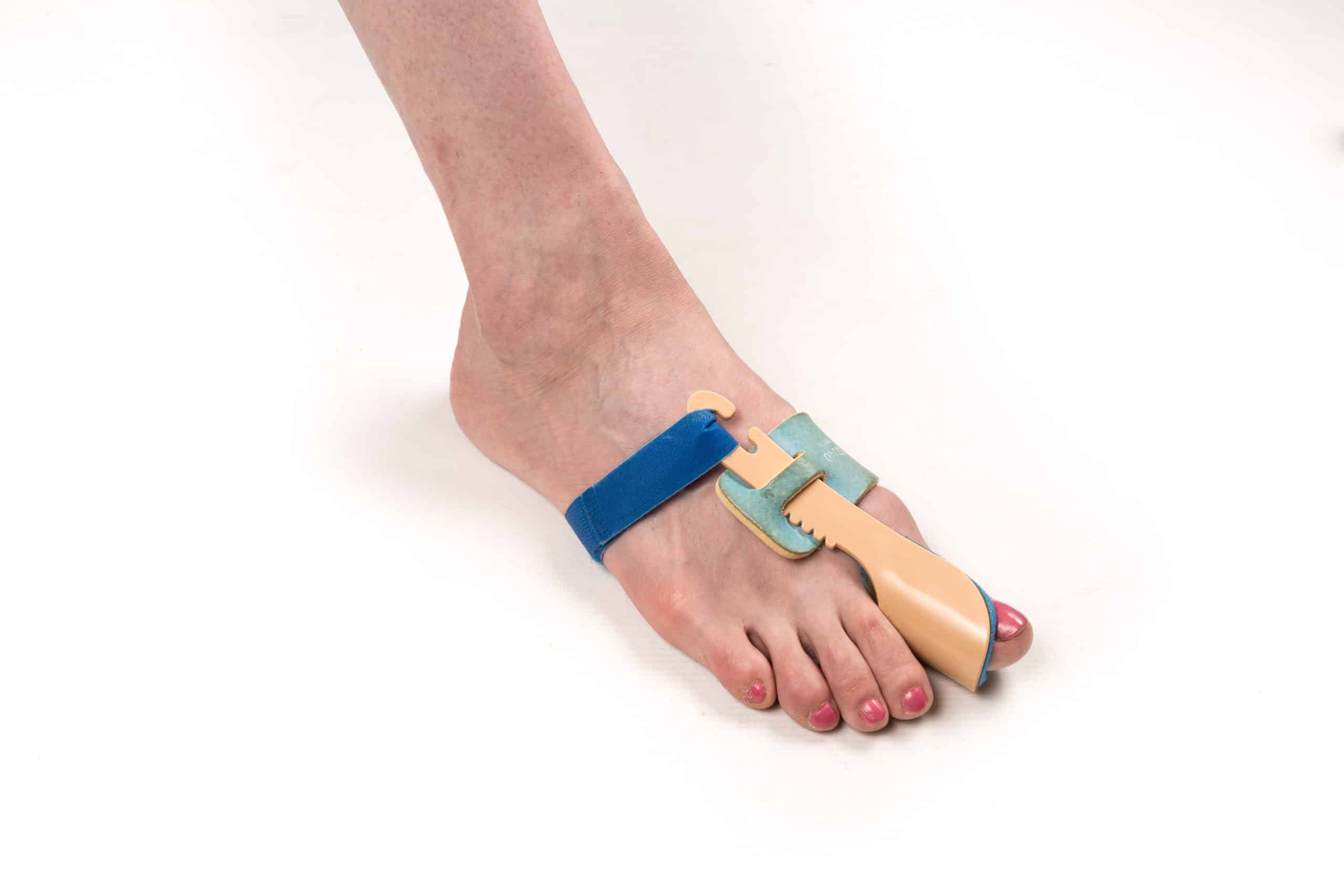
Bunion correctors often help to minimize severe pain. However, they often lead to pressure points on the skin.
Do bunion correctors work? The advantage of a bunion corrector: quick help at low cost. The disadvantage: due to the pressure that the corrector builds up, patients often continue to have pain. Especially in the first few weeks, bunion correctors can cause pain and often irritate the skin. This pain usually goes away after a few weeks, once the foot has become accustomed to the pressure. Bunion correctors certainly offer a way of not worsening the status quo or slightly improving it. Note: Opinions on correctors are controversial. Some specialists advocate the use of bunion correctors because they can relieve pain. Other specialists share the opinion that the hallux valgus deformity cannot be corrected and therefore the indication for a corrector is not given.
2. bandages for bunion
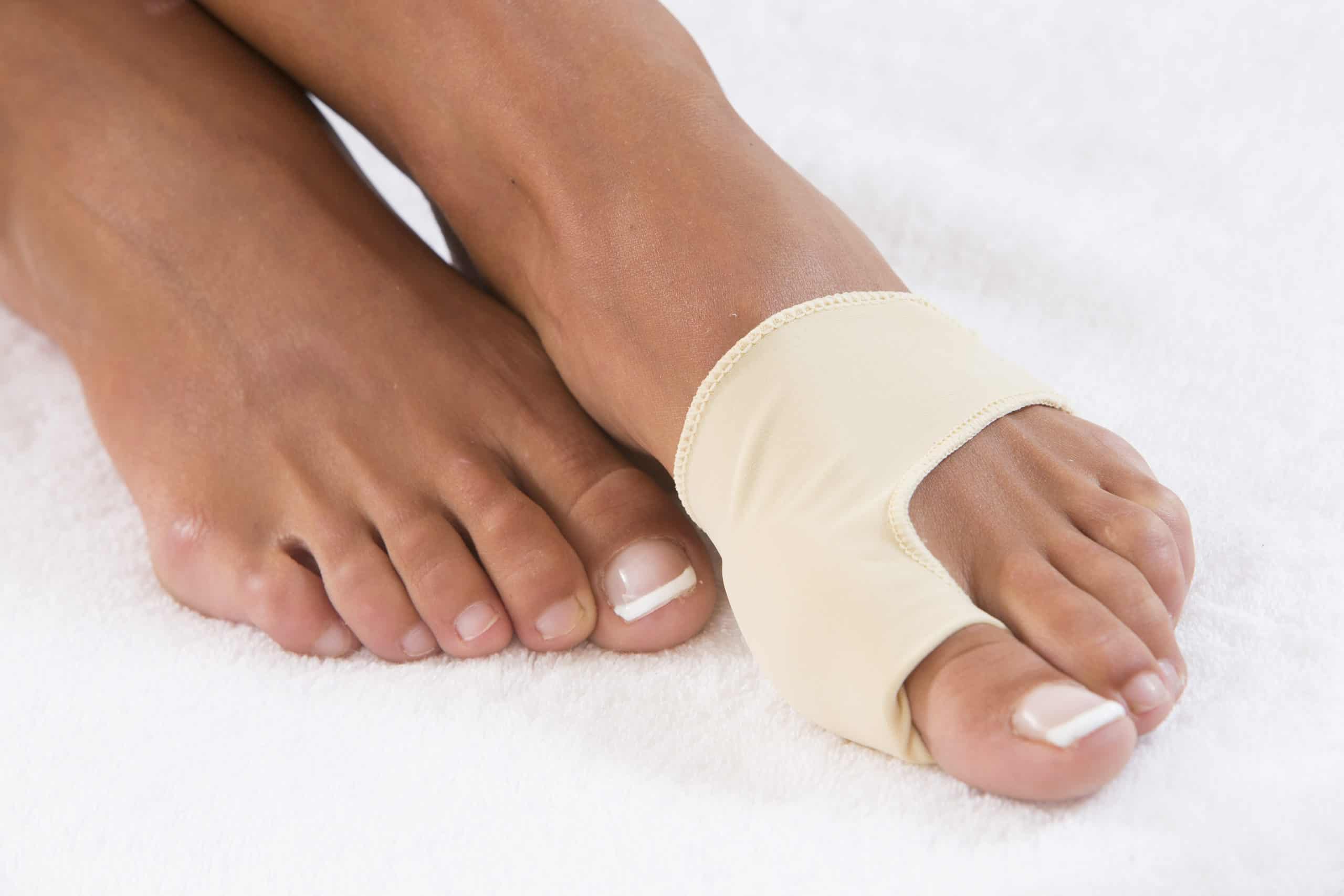
Bunion sleeves often help prevent a bunion from worsening and exert less pressure on the skin than splints.
If a bunion corrector causes pain, a bandage can be fitted by the treating orthopaedist. Due to the even pressure, the wearing comfort is greater than with splints. If you are still in pain after wearing a splint or bandage, surgery on the forefoot is recommended. Bunion surgery helps to get rid of it in the long term.
3. bunion massages - ointments & creams
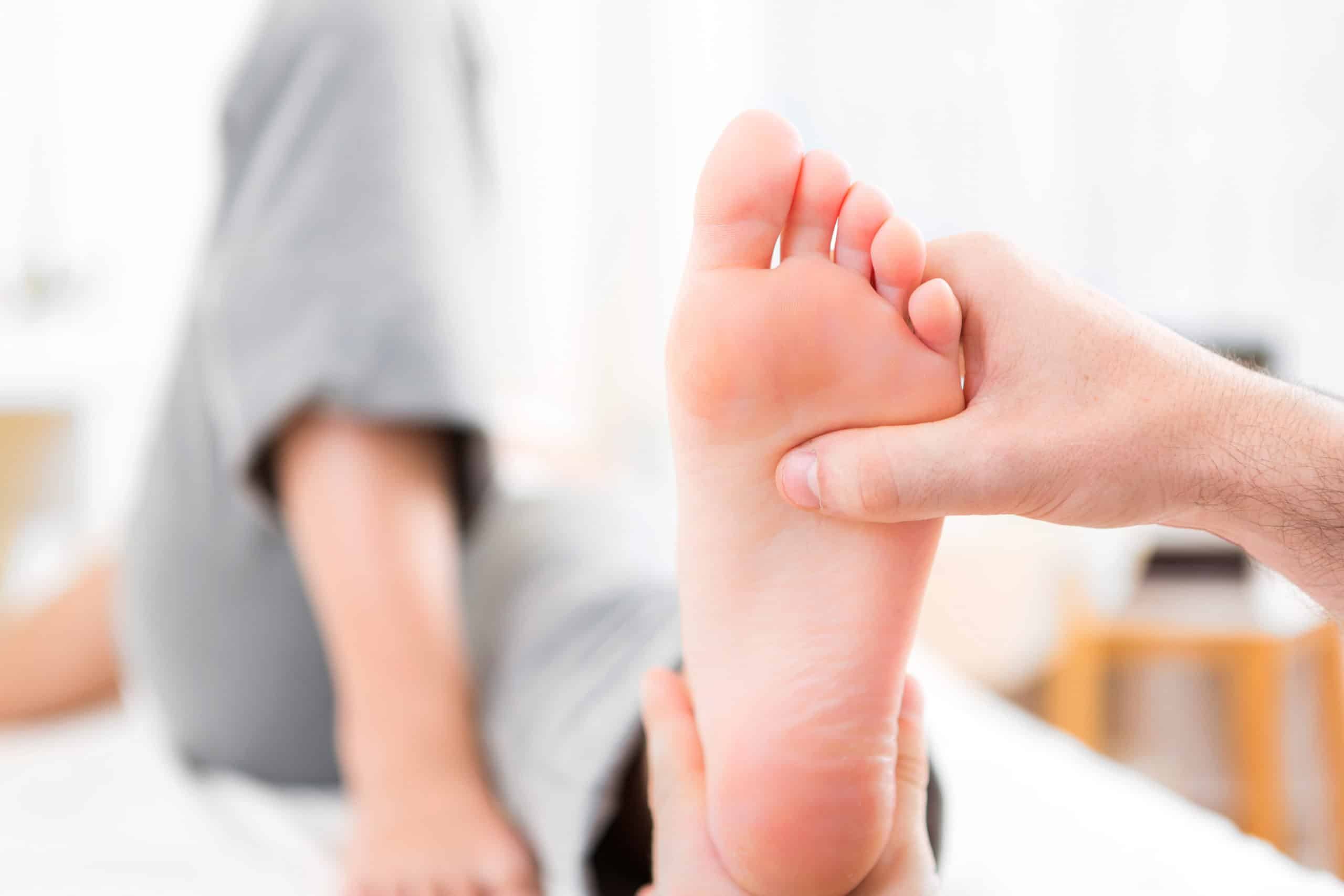
The method of “massaging away bunion” or hallux valgus massages is controversial among experts. Natural healing of bunions through massages has not been scientifically proven. Nevertheless, massages on the big toe support the patient´s feeling of well-being. Tension in the forefoot can be reduced by massages.
The method of “massaging away a bunion” is controversial. Massages certainly help to relieve acute pain in the forefoot and contribute to the general well-being of the patient. However, bunion massages cannot reduce or heal a bunion. More effective than massages are certainly bunion exercises for in-between, such as the blind one-leg stand while brushing your teeth. Bunion ointments and creams are just as beneficial. However, they only promise short-term pain relief. To complete the conservative treatment options, there are also toe spreaders, rollers for the balls of the feet, special pads (toe pads), insoles, and tapes in addition to the methods mentioned. All have the same goals: To delay surgery as long as possible and to suppress pain as much as possible. However, before you decide on a treatment, you should definitely talk to your doctor or physiotherapist about the best care for your foot.
4. Bunion surgery - what experts agree on
Here, experts agree: if you want to reduce the pain caused by bunions develop, long-term remove it and get the grip on it, Surgery by a Specialists help. Here, the choice of an experienced surgeon is important. The literature speaks of almost 200 different types of bunion surgery and Techniques. However, only a few of them are actually practiced in everyday life. Depending on the degree of severity, the surgical technique or the OP method, and the used OP material. The most common methods are Bunion correction after Austin, Scarf-Osteotomy, Akin, Lapidus arthrodesis, TMT I Arthrodesis, and Chevron-Osteotomy. All surgical methods have the same goal: to restore a straight toe without pain with a full range of motion.
These types of bunion surgery are the most common and proven surgical techniques. They correspond to the gold standard or the current state-of-the-art surgical method.
Advantage of bunion surgery: The position of the toe can be corrected quickly and permanently. The chances of success that the bunion will disappear forever are high. In addition, there are Surgical techniques that make natural healing possible. Here, many podiatrists use bone screws (screws made from human bone) as standard, such as the Shark Screw®. The great advantage for the patients for whom these screws are used: No metal removal, weather sensitivity, and no foreign body in the bone.
The disadvantage of surgery: it involves certain risks, especially if metal screws are used. In addition, you are unable to work for about 1 – 6 weeks after surgery, as the foot has to be relieved after surgery. After about 6 weeks, you can start normal weight-bearing without the use of a bunion shoe. After approx. 8 – 12 weeks you can run, hike, or do other sports again without pain.
Choice of surgical material and technique
Besides the choice of the Podiatrists in your Region the choice of surgical material is crucial for patient satisfaction. A variety of plates and screws are available to the surgeon: screws made of metal, Screws made from human bone How the Shark Screw® – your Allograft or also bioreactive Synthetic polymer screwswhich dissolve in the bone. Each material has certain properties that can have different effects on the patient. That is why it is best to know before the Surgery about the different possibilities. So can Metal screws a second surgery to Metal removal required make. Bone screws on the other hand, are colonised by the patient’s cells, re-vascularized, supplied with blood and transformed into the patient’s own bone. After about one year, they are completely remodelled to the patient’s own bone and are no longer visible in X-rays. Thus saves the patient has a second surgery for metal removal.
Material | Indikation | Vorteile | Risiken |
Shark Screw® / Schraube aus menschlichen Knochen | Hallux valgus Schweregrad LEVEL l - IV | Winkel 12° - 20° | Hallux valgus Korrektur nach Austin, Scarf, Akin, Lapidus, Chevron | Integration in Knochenumbauprozess | Keine Metallentfernung | Keine Wetterfühligkeit bekannt | Geringe Schmerzen nach der Operation | Besondere Vorsicht bei der Belastung des Fußes 1 - 4 Wochen nach der Operation erforderlich |
Schrauben aus Metall / Metalllegierungen | Hallux valgus Schweregrad LEVEL l - lll | Winkel 12° - 20° | Hallux valgus Korrektur nach Austin, Scarf, Akin, Lapidus, Chevron | OP-Methode einfach für jeden Chirurgen | Metallentfernung möglich | Metall im körper | Einsatz bei Allergikern & Wetterfühligkeit vermeiden |
Plattensysteme | Hallux valgus Schweregrad LEVEL lll - VI | Winkel 12° - 20° | Hallux valgus Korrektur Scarf, Lapidus | Hohe Festigkeit und Stabilität | Metallentfernung wahrscheinlich | Trägt auf | Einsatz bei Allergikern & Wetterfühligkeit vermeiden | längere Heilungsdauer & schwerer Wunderverschluss möglich |
Resorbierbare Schrauben | Hallux valgus Schweregrad LEVEL l - lll | Winkel 12° - 20° | Hallux valgus Korrektur nach Austin, Scarf, Akin, Chevron | Lösen sich im Körper auf | Kein Metall im Körper | Können Gewebwirritationen aufrufen | Geringe Stabilität | Auflösungsprozess kann Schmerzen hervorrufen |
Heal bunion naturally - surgery with screws from human bone
Screws made from human bone (bone screws) are vascularized and colonised by the body’s own cells after insertion into the bone and thus integrated into the natural bone remodelling process. This is possible because inside these screws there is a natural system of channels, the so-called Havers channels. The body’s own vessels and bone cells can settle and spread in these structures. This creates bone structures that constantly adapt to the mechanical demands of the foot and eventually become the body’s own bone. This fact saves patients the second operation for metal removal and the associated risks, sick leave and time spent.
In contrast, foreign materials such as metals remain in the bone as foreign bodies unless they are removed during a second operation.
Recommendation:
You suffer from a bunion and you are looking for a surgeon in your area who can provide you with Shark Screw® or give you a second opinion on your condition? Write to us and we will recommend the best foot surgeons to you free of charge. Doctors who are recommended by us regularly take part in bunion / hallux valgus training and surgery courses. Therefore, they can draw on a wide range of experience in bunion surgeries.
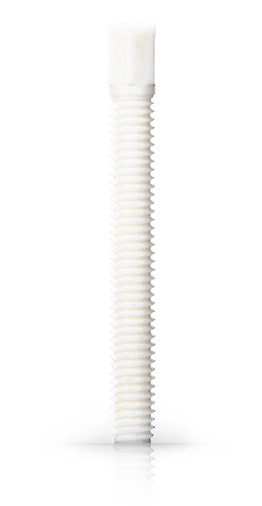
Types of bunion surgery
Bunion surgery can be performed under local or general anaesthesia. You as the patient decide together with your anaesthetist whether you want a local or general anaesthetic. To avoid nerve damage during surgery, the surgeon opens the metatarsophalangeal joint while protecting the vessels and nerves. To get a better picture of bunion surgery, watch this video of bunion surgery.
Bunion surgery recovery
After bunion surgery, the inpatient stay is approx. 1 – 3 days. Depending on the degree of swelling of the foot, the stay may be longer. After surgery, it is important that you take the best possible care of your operated foot and keep it elevated and relieved. Immediately after surgery, you will be given a forefoot relief shoe, which you must wear for the next 4 weeks. Without this shoe, walking is strictly prohibited. If you do not follow the aftercare of your bunion surgery This is because the bone may not heal and surgery may have to be performed again. Often the surgeon prescribes physiotherapy sessions so that healing can take place even more efficiently. After surgery, the foot needs at least four weeks of rest before it can be fully loaded again. During this time, it is possible to work in the “home office”. After about 8 – 12 weeks, you will be able to do sports again without any restrictions and without pain.
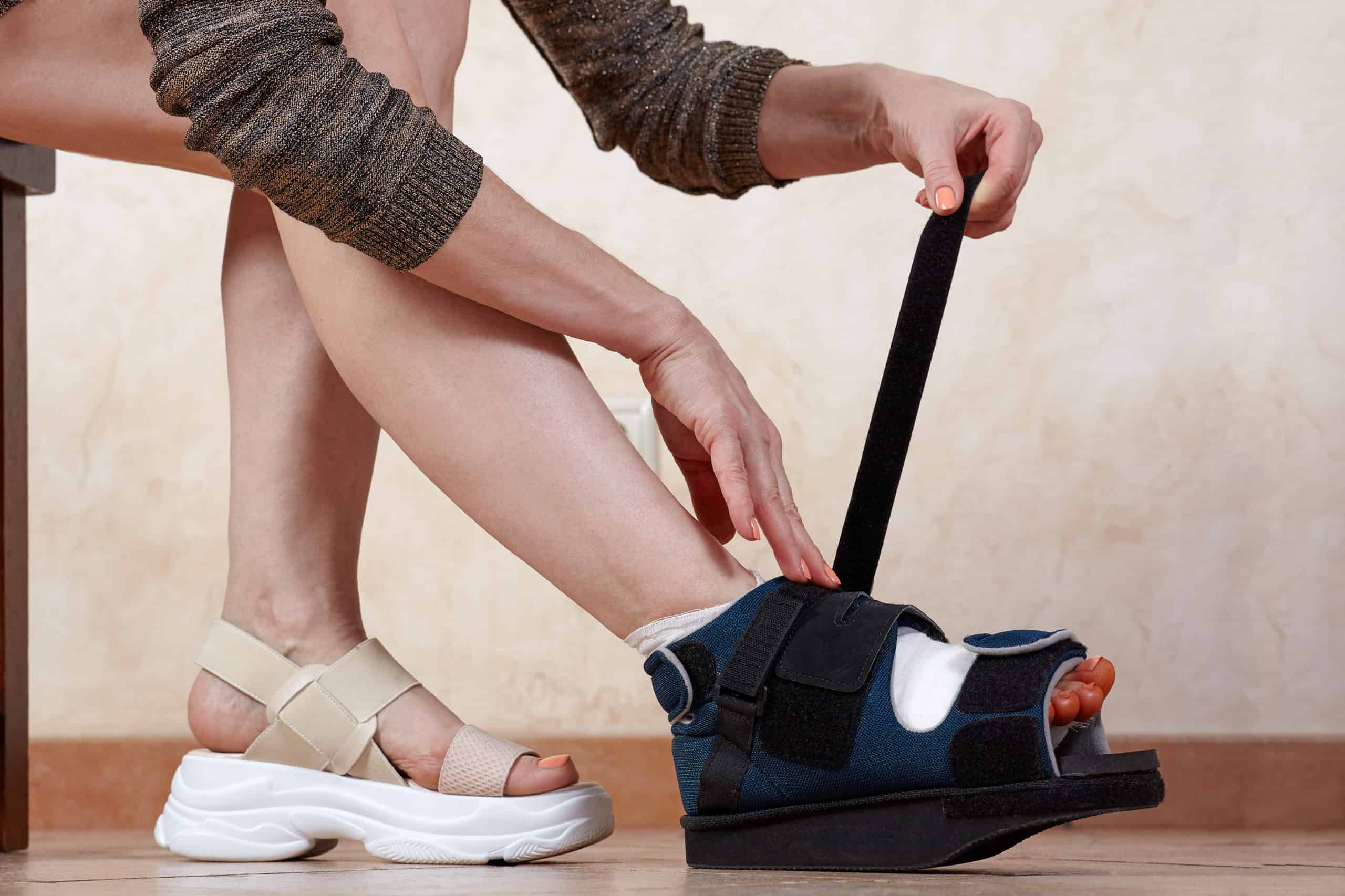
This is what a classic forefoot relief shoe (Hallux shoe) looks like, which must be worn for about four weeks after surgery. Putting weight on the foot without the shoe should be avoided at all costs. Weight-bearing without the bunion shoe can prevent the healing of the bone and make a second operation necessary. Therefore, always follow your doctor’s instructions exactly.
Causes and risk groups for bunion / hallux valgus
The development of a bunion depends on various factors and can also be genetically influenced or promoted by certain movement patterns. This guide explains the risk groups and causes of bunion.
Wearing high heels
People who often wear shoes with high heels are at a clear disadvantage: the toes are pressed tightly together in the shoe. This causes high loads on the toes and especially on the metatarsophalangeal joint of the big toe. If high heels are worn regularly and over a long period of time, this can promote or result in a bunion or hallux valgus interphalangeus. It is therefore important to compensate for the frequent wearing of high heels: regular foot exercises and frequent barefoot walking. This strengthens the transverse and longitudinal arch of the foot.
The genetics - predisposition in hallux valgus
It happens that people within the family suffer from hallux valgus or hallux valgus interphalangeus. The reason for this is usually predisposition and genetics. Children inherit stunted toes, a splay foot, poor anatomy or weak connective tissue from their parents and grandparents. Is a hallux valgus preprogrammed in these cases? No in no case, experts agree. Here, too, regular foot exercises and wearing flat shoes help to prevent hallux valgus. In addition, malpositions of the foot in childhood and adolescence can be corrected quickly, naturally and sustainably without surgery, together with the orthopedist. Deformities of the toes are also favored by rheumatic diseases, accidents or overweight.
Bunion: these are the most common symptoms
This is how a bunion becomes noticeable: In many cases, a bunion can be recognized by the eye. The head of the metatarsophalangeal joint of the big toe leans towards the middle of the body (medial). This means that no clear, straight line of the big toe is visible. Another symptom or indication of bunion is reddened and very thickened skin at the level of the head of the metatarsophalangeal joint.
The “knob” or “ball” (often called a frost bunion or bunion toe) that forms on the inner edge of the foot is also called a pseudo-exostosis. This pseudo-exostosis is the metatarsal head of the first toe (metatarsal I head) being pushed towards the center of the body. The skin may often be swollen or red over this.
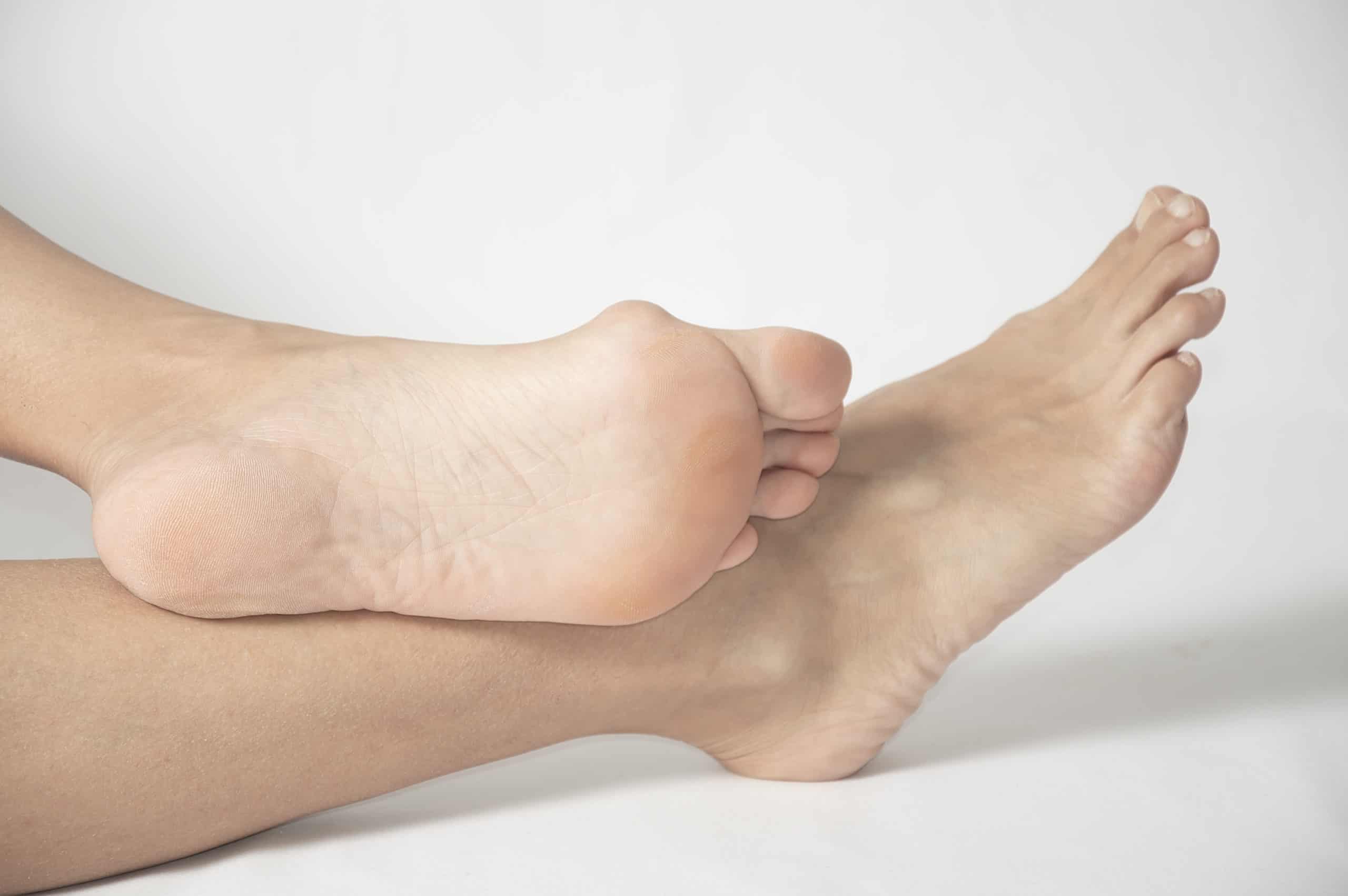
To be seen in the picture: Bunion. The metatarsal head of the big toe drifts into the middle of the body (medial). The big toe straightens outwards and displaces the other toes.
Feeling of pressure & pain in the forefoot and on the inner edge of the foot
Bunion often causes the patient unpleasant pain. This often extends from the inside of the foot to the forefoot. However, pressure pain at the “frost bump“, where the head of the big toe curves inwards, is typical. Tight shoes, thickened skin at the pressure points, inflammation of the bursa in the joint, and arthritis in the joint of the big toe are the most common causes. If the pain increases, you should consult a doctor and clarify the causes before further symptoms appear and the condition restricts your everyday life. If the pain is ignored, damage such as osteoarthritis in the metatarsophalangeal joint of the big toe may occur.
Bunion: Examinations - Diagnosis - Field reports - Results
Examination and diagnosis of a bunion
Often, a good orthopedist, foot surgeon, or trauma surgeon only needs to take one quick glance and the diagnosis is made. In order to be able to draw conclusions about the exact angle of the crooked toe, an X-ray is first necessary in case of severe pain and a planned operation. It is important that this is done while the patient is standing. This allows a more exact determination of the bunion angle and intermetatarsal angle under load and the identification of possible arthrosis. The therapy is usually different for adults and children: while conservative treatment (without surgery) is often possible in children, surgery with natural materials is often a good option for adults who want long-term healing.
Field reports and results
The results and experience reports vary greatly, but in 85% – 90% of cases the patients are very satisfied with the result of the surgery. The subjective experiences with bone screws(screws made from human bone) show little pain for the patients in the postoperative course, which is due to the natural healing of the screw. Due to the biological origin, there is excellent tolerance in contrast to metal screws, which can cause pain if the patient is sensitive to the weather.
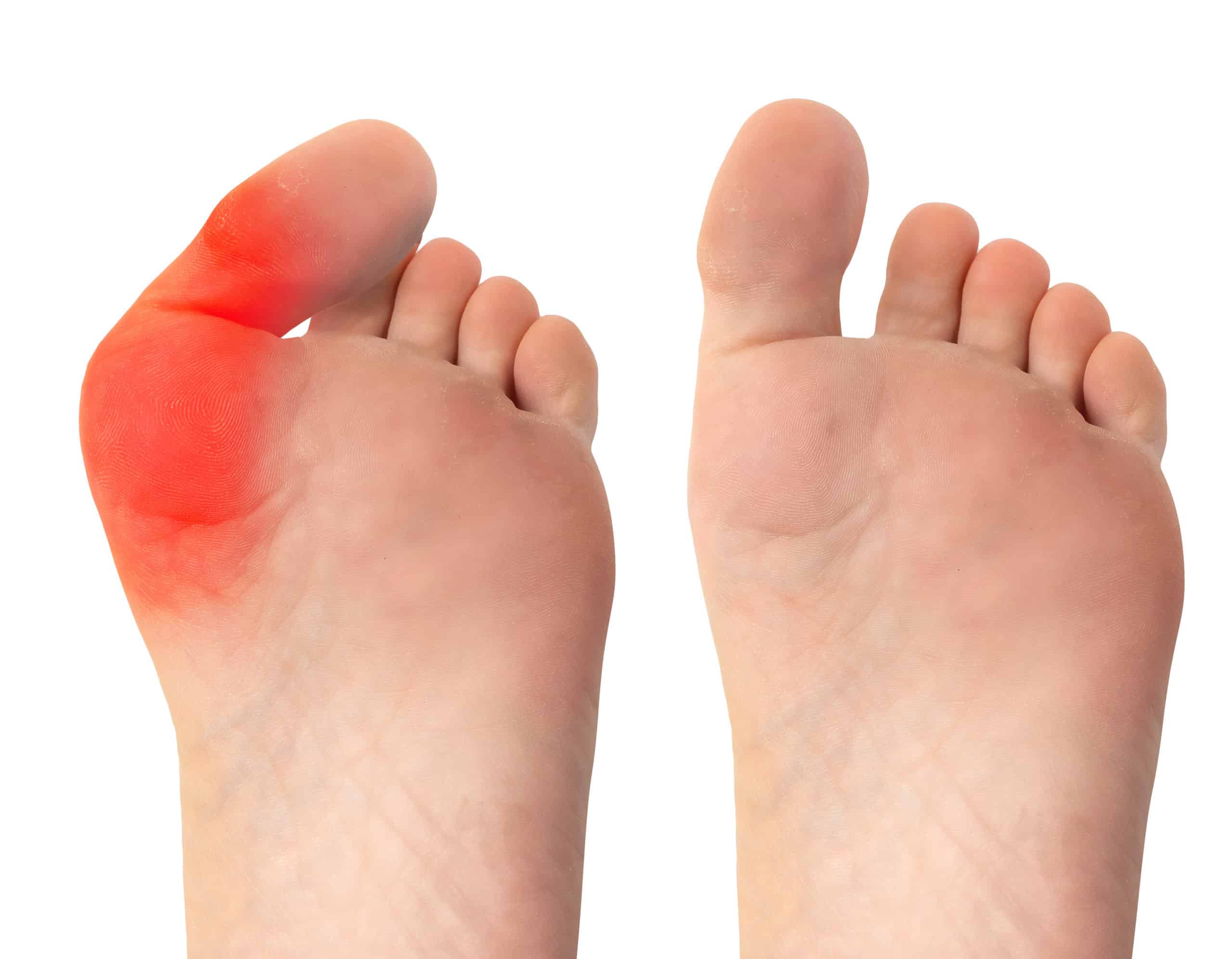
Shown in the picture: Before – after image of a bunion. Generally, 85% – 90% of patients are satisfied with the result of the operation.
FAQs - frequently asked questions
Bunion surgery is performed under local or general anesthesia, depending on the hospital and patient preference. Screws made from human bone have proven successful in operations. These save patients from having to undergo a second metal removal surgery. The greater the deformity, the longer the surgery may take. As a rule, bunion surgery lasts between 45 minutes and 100 minutes. Since bunion surgery is a standard procedure that is performed about 80,000 times a year in Austria & Germany, complications are very rare and the chances of recovery are very high. The literature speaks of a 0.7% – 6.0% failure rate.1 Bone screws offer particularly high chances of success here.
1 C. Lin, Y.M. Cheng, J.K. Chang, C.H. Chen, P.J. Huang, Minimally invasive distal metatarsal osteotomy for mild-to-moderate hallux valgus deformity. Kaohsiung. J. Med. Sci. 25 (2009) 431-437.
The Shark Screw® can be used for all degrees of deformity, i.e. for mild, moderate and severe deformities. Thus, the Shark Screw® is suitable for all degrees of deformity for which metals (plates/screws), alloys, metal wires or reactive plastic are otherwise used.
Bunion surgeries are low risk. Approximately 80,000 operations are performed annually in Germany and Austria. With the choice of an experienced surgeon and the right surgical method and surgical materials, the failure of surgery is approximately 0.7% – 6.0%. Nerve damage or vascular damage can only occur if the surgeon injures nerves or vessels during surgery. However, this is usually not the case. It is essential to test for incompatibilities such as metals or bioactive substances in the body beforehand. Screws made from human bone offer the optimal opportunity for low-risk healing.
As a rule, after the bunion surgery, a hallux shoe must be worn for about 4 – 6 weeks. During this period, home office work is possible and office work is limited. For physically demanding activities, with a lot of movement or standing time, a rest period of 4 – 6 weeks is required. The hospital stay is usually only a few hours or max. 1 – 2 days.
In Austria, the costs of bunion surgery are usually covered by health insurance in public hospitals. In private clinics, supplementary insurance covers the additional costs incurred for bunion surgery. However, this is true in other countries.
There is no evidence that bunion can regress naturally. In the long term, surgery on the forefoot can help with hallux valgus, depending on the severity. Screws made from human bone have proven their worth here.
If a bunion leads to pain in everyday life, surgery may be considered. Here, the bunion angle and the pain in the foot are always decisive. Without surgery, osteoarthritis can develop. Screws made of human bone have proven to be the best surgical therapy, as they do not have to be removed again like metal screws. Whether a bunion should be operated on must be decided together with an orthopedist.
Against a bunion help: Shoe insoles, foot gymnastics, surgery of bunion, toe gymnastics, insoles in case of splayfoot, physiotherapy, massages, correctors, taps, bandages. Treatment should always be coordinated with an expert. Screws made from human bone have proven their worth in operations.
Studies have shown that you should not drive a car for 4 – 6 weeks after bunion surgery. The reason for this is that the operated foot needs rest in order to heal. Elevated positioning helps to speed up the healing process. In addition, screws made from human bone do not require metal removal.
To interrupt the progression of the disease, bunion bandages and bunion correctors help. A true cure can usually only be achieved through surgery. Screws made of human bone are promising for surgery because they do not have to be removed again like metal screws.
Whether a bunion should be operated on should be clarified with the respective doctor according to the severity and pain of the patient. Screws made of human bone have proven successful in hallux valgus surgery. These bond with the patient’s bone, are remodeled into the patient’s own bone, and do not have to be removed again like metal screws.
Bandages, gymnastics and splints help to stop the progression of hallux valgus. However, only surgery can really help in most cases. Screws made of bone are particularly effective here, as they do not require a second surgery to remove the metal screw.
The recovery after bunion surgery usually takes 4 – 6 weeks. After this time, the bone has normally grown back together. Screws made of human bone are considered particularly patient-friendly and safe here, as they spare the patient the second operation of metal removal.
The operated foot should not get wet until the wound on the skin has healed. If water gets on the wound before this, germs can enter the wound and the wound can become inflamed as a result. As a rule, wound healing should be completed after approximately 7 – 10 days. However, this time varies from patient to patient.
The sensation of pain can vary and is different from patient to patient. The least pain is expected with screws made from human bone. Metal screws can cause tissue irritation and pain when the weather changes. Resorbable screws may cause pain for a prolonged period after surgery due to the degradation process. These can last several years (2-6) in some circumstances.

The author - Dr. Klaus Pastl
Dr. Klaus Pastl is a specialist for orthopedics and orthopedic surgery in Linz / Austria, specialist for foot and hallux surgery, additive specialist for hand surgery, additive specialist for rheumatoid orthopedics, general. sworn and court certified expert and additive specialist in sports orthopedics. He draws on a wealth of experience of over 15,000 operations performed independently.
In addition to his work as a surgeon, Dr. Klaus Pastl is a teaching foot surgeon at various foot surgery courses.

